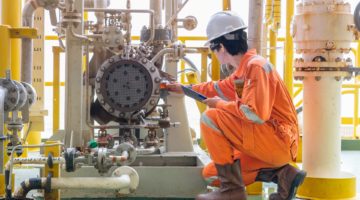As the renewable energy market continues to grow, companies need to invest in the long-term health of their green assets, to keep them operational, generating new cleaner energy. Over the last few years, Progressive has seen a noticeable shift amongst our traditional energy client base towards greener energy. Here we highlight why, more than ever, there’s a need for best-of-breed asset management solutions to support the energy industry transition.
Diversifying an existing portfolio
Renewable energy made up almost half of Britain’s electricity generation in the first three months of 2020 – a new record for renewable energy.
Source: GOV.UK Department for Business, Energy and Industrial Strategy in The Guardian.
And in October 2021, Boris Johnson, the UK’s prime minister, pledged £160m to upgrade ports and factories for building wind turbines making the promise that by 2030, every home in the UK would be powered by wind energy.
Source: BBC News
With the appetite growing for renewables both in the UK and overseas and many countries developing targets for reduced or net-zero emissions – those energy companies that traditionally relied on fossil fuels are starting to put more emphasis in diversifying their portfolios.
This is not something that’s new in energy, oil and gas companies have been building on their diversification strategies for years. But in the wake of a fall in oil prices, COVID 19 and increased climate change pressures, traditional oil and gas companies are ramping up their green investments. Here are some examples of some green projects happening in the oil and gas sector.
Equinor owns 75% of Hywind in Scotland a wind turbine generation plant about 30km out in the North Sea and has started building (with SSE renewables) a large windfarm off Dogger Bank that will allegedly make up 5% of UK’s estimated electricity generation.
Shell Australia announced in February 2020 that they are building a large-scale solar plant made up of around 400,000 photovoltaic panels in Queensland, Australia as part of Shell’s global greening strategies.
The Parkmead Group acquired Pitreadie Farm Ltd last year. The site comprising 939 hectares in Aberdeen, Scotland will feature installations of wind turbines, a solar farm and a biomass production facility.
As part of their strategy of diversification in the UK energy market iGas has very recently acquired geothermal energy company GT energy to look into developing redundant oil and gas wells for geothermic use.
New green businesses
There has also been a profusion of companies that have a sole focus on green energy sources. Consumers have been moving to many of these suppliers (such as Octopus Energy and Ecotricity). And in the UK, green energy start-ups have also been slowly gaining funding from energy companies including Oxford PV – focusing on solar panel optimisation, BBOXX – who create ‘plug and play’ solar systems, with a focus on African territory sales, and Ripple Energy – who are building the world’s first consumer-owned wind farm.
As part of the Paris agreement, Africa has been developing partnerships with agencies and businesses to ensure that their clean energy goals are met by 2020. As an example, a recent partnership has been announced between the International Renewable Energy Agency (IRENA) and the African Development Bank (AfDB) to boost green energy funding. Many renewable projects are emerging to meet these green energy targets, these include Lekela – has wind farm projects in Egypt, Ghana, Senegal and South Africa, Quaint Global Energy – develops large scale clean energy projects from their base in Nigeria, and Solinc East Africa – manufactures and supplies solar panels from their large plant in Kenya.
Both the old guard and the new players in the energy sector are looking to get projects up and running as soon as possible and so will need a robust infrastructure that supports the procurement, construction, operation and maintenance for their green assets.
Maximise the performance of green assets – the key to success
The growth in green energy generation is an extremely positive step for the future of our planet. But it’s also hugely important to its future that these companies succeed. Key to this success is that these companies operate efficiently with minimal outages in energy generation. To do so, they will need to invest in the long-term health of their green assets by implementing effective strategies and technologies to manage their assets across their sites.
Effective asset management
- Real-time monitoring of the health of operational assets
- Optimised maintenance of all assets (operational and auxiliary)
- Well managed inventory of spare parts and equipment
- Enable mobile workers to access and update key data
- Develop asset management policies and budgets
How Progressive TSL can help
Asset Monitoring
Because renewable energy production is typically based on new technology, many of these assets come with hundreds of in-built IoT sensors as standard. Sensors enable the health of the asset to be monitored remotely, which can be very advantageous as renewable energy assets are often located remotely, e.g. offshore wind farms, tidal power systems or desert-based solar farms.
These sensors can be configured to remotely collect vast amounts of data about the health of the asset. By monitoring pressures, rotation rates, vibrations, temperatures etc. and analysing trends in performance this data can be used to identify issues that have the potential to detrimentally impact on the performance of the asset and ultimately production levels.
Using the wealth of data entering the SCADA system, along with sensor data, EAM solutions utilises Data Lakes to store the data and AI technology to analyse patterns in performance and trends. Progressive TSL harnesses this data and uses it as a key driver of their client’s asset performance management.
It would be impossible for a human to collect and analyse such huge volumes of data. However, the data collected by sensors will only provide part of the picture. This information should be supplemented by observations made by the technicians working on site. During asset maintenance and inspections, technicians can identify issues and non-conformities that, based on their experience, they know need to be considered. Using Progressive TSL’s mobile working solutions, these technicians can record what they see, send the information back to the central control room and where appropriate, trigger an escalation workflow.
Manage Asset Maintenance
Enterprise Asset Management (EAM) solutions (Progressive implement both HxGN EAM – formerly Infor EAM and IBM Maximo) use data collected and analysed using technologies such as those described above to plan both asset inspection visits and any resulting maintenance work. Responding to asset performance information enables you to minimise downtime and unnecessary usage of spare parts by moving away from simple regular maintenance planning, based solely on hours of usage, to more intelligent maintenance strategies. The EAM system automatically generates work orders and necessary purchase orders when new parts or equipment is needed to perform the work. The system will track the progress of the work and manage any necessary Permit to Work (PTW) and Delegation of Authority (DOA) workflows.
For more information on Progressive’s Asset Maintenance Solutions, please follow the link to our recent CMMS blog.
Inventory Management
In order to minimise downtime when maintenance is necessary, stocks of key spare parts must be managed effectively. Progressive’s EAM inventory management solution provides a real-time view of stock across all locations with automated replenishment for key parts. The system will recognise lead times, and when just-in-time ordering is not appropriate.
Procurement
The EAM system will manage the purchasing process, including the approvals workflow. The process will be streamlined with alerts to highlight any delays. The system links directly with your finance system for integrated procurement processing. The system includes Contract Management functionality for supplier relationship management.
For further information about Progressive’s Inventory and Procurement Management solutions, see our getting a handle on your inventory blog
Mobile Working
The EAM System can be extended to support technicians working on-site. This enables them to access and update key data in real-time directly from their mobile devices, including work order status, work permits, safety instructions, maintenance history, SLAs and Bill of Materials and as described above, observations from asset inspections. For more information on Mobile Working Solutions, read this article.
Budgetary and Policy Planning
An effective asset management policy should not just be about managing the day-to-day maintenance of assets. Progressive’s expertise and technology solutions also help our clients to develop effective long-term policies. The solution can be used for generating decay curves, equipment ranking, energy scoring, cost analysis and ultimately replacement and overhaul planning and budgeting.
Progressive TSL offers a fully integrated Asset Maintenance, Procurement and Inventory Management solution to maximise performance of energy production assets efficiently and effectively.
About Progressive
Get in touch with Progressive TSL. Our large team of EAM consultants have vast experience and expertise of implementing asset management strategies using HxGN EAM and IBM Maximo across a range of asset-intensive industries, including 15 years of delivering solutions to the energy sector. Progressive TSL is also Infor and Hexagon Gold Partners and an IBM Gold Business Partner; when it comes to asset management, our specialist knowledge is second to none.




